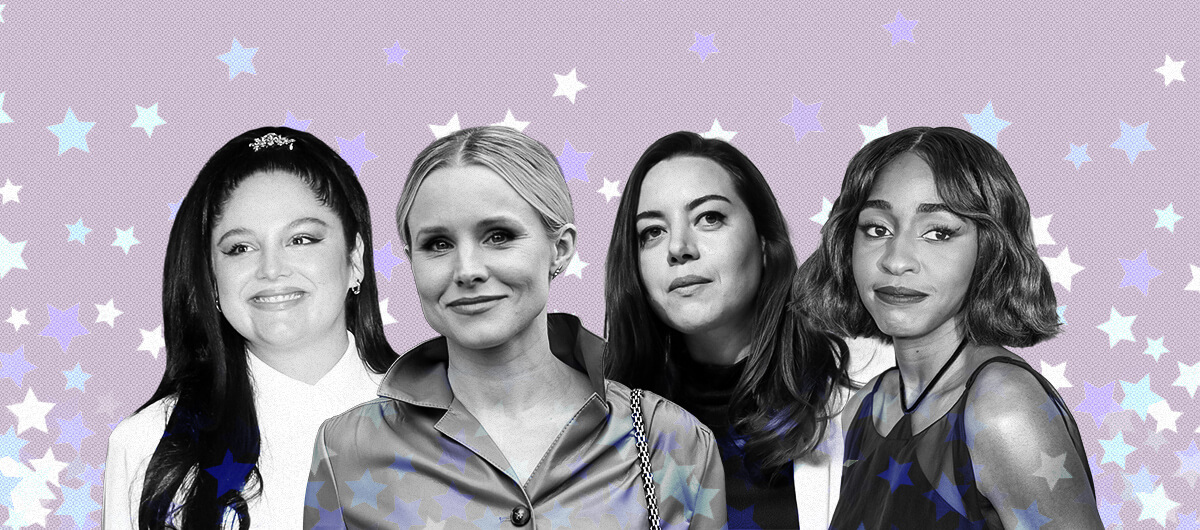

Pop Culture
Neurotic Women Protagonists Are Having a Moment
As the author argues, early 2000s comedies like 'Mean Girls' and 'Freaky Friday' featured two-dimensional leads. But with more women taking the helm in the industry, emotionally complex comic characters who were traditionally cast as sidekicks are finally taking center stage
This article was made possible because of the generous support of DAME members. We urgently need your help to keep publishing. Will you contribute just $5 a month to support our journalism?
For over two decades I’ve been wondering what was so appealing about Lindsay Lohan’s protagonist, Cady Heron, in the 2004 movie Mean Girls. The teen comedy follows Cady, a homeschooled girl from an African country, who moves to an American high school only to get caught up in the drama of being popular. But this character has little agency and instead mirrors others including the unpopular sidekick, Janis (Lizzy Caplan), the popular girls known as The Plastics, and even her teacher, Ms. Norbury (Tina Fey). The story happens to her, not because of her.
Imagine if audiences had paid more attention to the supporting character, Janis. She manages the movie’s complete trajectory by recruiting Cady into her scheme to take down mean girl Regina George (Rachel McAdams) and even narrates her vision — with surgical precision by writing on a chalkboard — for a new social hierarchy. She stays true to herself despite quintessential high school–style pressure to wipe off her thick black eyeliner and wear trendier clothes.
Twenty years ago, characters like Janis served as supporting players, not as lead characters. Instead we had more two-dimensional portrayals of women often cast in aspirationally romantic, polished, and palatable roles. With Hollywood’s reboot machine running on Y2K nostalgia — Freaky Friday, Practical Magic, The Devil Wears Prada, My Best Friend’s Wedding — it’s time to examine whether this is the same stale recycled intellectual property or if female leads have actually evolved.
While light-fare films featuring reductive female archetypes still exist, the broader cultural appetite for more complexity in our leading ladies has shifted. Our collective understanding of gender, race, and representation has deepened, in part fueled by social media’s power to bear witness and demand accountability.
And sexist templates are dwindling as more women are put in charge. A 2021 Harvard Business Review study found that the #MeToo movement led to measurable improvements in gender equity across Hollywood. Production teams that previously had worked with Harvey Weinstein were significantly more likely to hire female writers after 2017, and those writers were more likely to create films with emotionally complex female characters and male protagonists who defied traditional gender stereotypes.
This shift wasn’t just about staffing — it reshaped the kinds of stories being told. The study concluded that #MeToo catalyzed a broader appetite for realism, especially narratives that confronted power imbalances and rejected sanitized portrayals of femininity.
There’s already been a shift on our screens. The weird girl, the best friend, and the morally ambiguous foil may not have gotten their due during my formative years, but today, main characters are no longer confined to glossy perfection — they’re emerging as the gloriously unhinged, ethically murky, emotionally complex women who mirror the rest of us. They are the story.
In Nobody Wants This, whose second season just dropped on October 23, Kristen Bell’s Joanne is teeming with adorable modern-day neuroticism. As an agonistic sex-and-dating podcaster navigating a relationship with a rabbi, Joanne was caught between radical independence and the allure of belonging. Her emotional impulsiveness — crashing ceremonies, oversharing, dodging spiritual commitment — made her messy, but not malicious. She was the kind of character who self-sabotaged with punchlines, then tried to rebuild with sincerity. She helped audiences reexamine the simplistic templates once used to portray single women.
And then there’s Megan Stalter’s character Jess in Lena Dunham’s Too Much (2025). “I’m, like, always adjusting my expectations,” said Jess in the premiere episode. With this line, Dunham nailed a hallmark trait of Gen-Z in subtly balancing neurotic self-awareness with performative vulnerability.
Jess had just moved to London to start over both personally and professionally after a bad breakup only to be disappointed by an apartment, her job, and any romantic prospects. She was not thin. She was rarely composed. She was often acting on impulse like she did during a drug-fueled dinner party and when she accidentally published private posts. From the start, Jess was set on a trajectory for a meaty story arc that deliciously unfolded when she finally realized that eliminating her ex’s new girlfriend wouldn’t actually solve her problems.
Shortly after its July 2025 release, Too Much was the tenth-most watched show on Netflix. It debuted with more than 20 times the average series demand in the U.S. and was compared to HBO hits like Hacks and The White Lotus. Stalter is my poster child for weird girl ascension; I love seeing a self-possessed woman navigating life with curves and quirks much as I do. She’s relatable.
In season two of The White Lotus, Aubrey Plaza gave us Piper, an unabashedly feminist archetype. She was constantly scanning power imbalances between the two couples on the trip, no doubt a skill she learned in her job as an attorney for victims of workplace harassment. She was aware of world issues. She voted. She rolled her eyes at perceived injustice.
What made her interesting was the softening of her initially rigid view of romantic relationships. She saw outward affection as insincere and grappled with emotional nuance, but by embracing vulnerability, her character evolved, ultimately realizing that owning her sexuality didn’t compromise her convictions. This more complex female character reflected a cultural reckoning with the ditzy stereotypes we once embraced.
Ayo Edebiri’s Sydney is a line cook in a male-dominated restaurant in The Bear and in lesser hands, her character could easily have been relegated to the sidelines. As Sydney would one day tell the chef, Carmy Berzatto, “I’m not your sous chef, I’m your partner.” In that dialogue, we bear witness to a young female co-star demanding recognition for her vision, not just her labor, challenging the established hierarchy.
Contributing to this character’s depth is perhaps Edebiri herself. She made her directorial debut on The Bear in season 3, with the episode titled “Napkins,” earning her nominations for an Emmy for Outstanding Directing for a Comedy Series and a DGA Award.
According to a report by Boxed In, women made up just 21% of key creative roles (creators, directors, writers, producers, executive producers, editors) in the 1997–1998 television season. By 2020-2021, that number had grown to 31%, with streaming platforms driving the most significant gains.
In film, women directed 16% of the top-grossing movies in 2023 — up from just 9% in 1998. And in 2024, women creators on streaming programs rose from 27% to 36%, with similar jumps in directing and writing roles. This is progress, yes, but we still have a ways to go.
With more women writing, directing, and producing we yield richer portrayals, allowing leads to drive the plot rather than merely react to it. Actress Jenna Ortega became an executive producer during the second season of the Netflix hit Wednesday, perching herself in the writers room adjacent to the legendary Tim Burton. The character’s refusal to smile and conform is a radical act in a world that often demands emotional softness from girls.
Another example of these audacious portrayals is Rue Bennett (Zendaya) in Euphoria. She’s not the aspirational “troubled girl” of early-2000s teen dramas but a raw, unfiltered portrait of real time addiction. Her trauma and volatility aren’t plot devices — they are the plot. Her spiral reflects the reality of a generation fluent in therapy-speak yet still struggling to feel okay. Rue embodies the modern heroine’s paradox: self-aware enough to diagnose her pain, but not yet healed enough to escape it.
Mental health awareness has shifted storytelling as audiences are no longer seeking tidy redemption arcs, but recognition. Leads like Zendaya, Bell, Stalter are rich with contradiction, rage, and emotional depth. As they bring another dimension to what makes a compelling leading lady, they reflect a cultural appetite for authenticity and relatability over aspiration.
When I rewatch movies from my formative years, I wish I had paid closer attention to the sidekicks. In American Pie (1999), Michelle (Allison Hannigan) was the uninhibited “band geek” who stole every scene from the male leads who were on a rote quest to lose their virginities. Owning her sexuality with confidence and oddness made her far more memorable than the juvenile guys driving the story.
In the teen cheerleading comedy Bring It On (2000), Torrance (Kirsten Dunst) predictably navigated the pressures of perfection and sportsmanship, but it was her friend Missy (Eliza Dushku) whose radical cynicism brought a much-needed layer of satire to the hyper-polished world of high school cheerleading. The real leading lady, though, should have been antagonist Isis (Gabrielle Union), who wouldn’t compromise her principles even with zero privilege to propel her dreams.
And I’ve always wanted a sequel to The Wedding Planner (2001). But instead of following main character Mary (Jennifer Lopez), the quintessential professional who’s lost in love, I want to know what happened to supporting actress Fran (Bridget Wilson-Sampras). She was “the bookie” who started an underground gambling ring before stuffing her tulle-covered self in a taxi and demanding more than a shady fiance who was flirting with the wedding planner. I wish I had her gusto before marrying my ex-husband.
To successfully lead now, modern women don’t have to be the sanitized ideal. They can be messy. They can be just like the rest of us. That’s what makes this moment in pop culture more than just nostalgic recycling. I’m watching the quiet evolution of the female lead ascend from the girl I wanted to be, to the one I actually am.
What were once the quirks and contradictions of supporting characters have become the defining features of today’s leading women. And the story doesn’t happen to them; it happens because of them.
We finally caught up to what supporting characters have been telling us all along: The most interesting women were never the ones chasing a man or a crown, but the ones on the sidelines playing by their own rules.
Before you go, we hope you’ll consider supporting DAME’s journalism.
Today, just tiny number of corporations and billionaire owners are in control the news we watch and read. That influence shapes our culture and our understanding of the world. But at DAME, we serve as a counterbalance by doing things differently. We’re reader funded, which means our only agenda is to serve our readers. No both sides, no false equivalencies, no billionaire interests. Just our mission to publish the information and reporting that help you navigate the most complex issues we face.
But to keep publishing, stay independent and paywall free for all, we urgently need more support. During our Spring Membership drive, we hope you’ll join the community helping to build a more equitable media landscape with a monthly membership of just $5.00 per month or one-time gift in any amount.




















































































